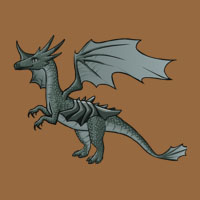Did you know that while dragons and their model species drakes are fictional and fanciful, the genetics of these virtual Geniverse creatures is based firmly on the real-world genetics of model organisms?
The drake genes and traits have been carefully compiled from the actual genes and associated traits of the anole lizard, mouse, fruit fly, zebrafish, and other model species. The genes for forelimbs, wings, color, and other drake traits are genes that are involved in the development of those traits in real organisms. There’s real biology behind the Geniverse narrative as well: the disease that plagues our hero’s dragon friend is modeled on a rare human metabolic disorder, ornithine transcarbamylase (OTC) deficiency. In fact, since the genes of humans are similar to the genes of the model organisms we use in real life—that’s why we can learn so much about human genetics from them—the genes of the Geniverse drakes are quite similar to human genes.
In addition, the interactive models that students use to conduct virtual experiments in Geniverse are powered by genetics programming that accurately simulates real-life patterns of inheritance in humans as well as model organisms. Students who learn with Geniverse are learning to analyze experimental results that would be obtained from these genes in a laboratory.
| Nomenclature | Genomic Location | ||
| Symbol | w | Chromosome | 1 |
| Name | wingless | Linkage map | 70 cM |
| Species | Dracomimus familiaris | Genome coordinates | unknown |
| Alleles and Phenotypes | |
| Allele | Summary |
| W | Presumptive wild-type allele |
| w | Recessive allele |
| Genotype | Phenotype |
| W/W | Normal wings |
| W/w | Normal wings |
| w/w | wingless |
| Nomenclature | Genomic Location | ||
| Symbol | Wnt1 | Chromosome | 1 |
| Name | Proto-oncogene Wnt-1 | Linkage map | unknown |
| Species | Dracomimus familiaris | Genome Coordinates | 1: 70 Mbp |
At the University of Massachusetts at Amherst, students are utilizing bioinformatics tools to build new drake genes, mutant alleles, and phenotypes based on investigations of the scientific literature. In an exploration of multiple genetic mechanisms, students have created drakes whose genotypes give rise to deafness and dwarfism, cancer and cold tolerance, polydactyly, and the ability to spit spider silk. We’re thrilled to see these additions to our drake genome!

